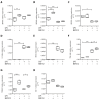The Selective Agonist for Sphingosine-1-Phosphate Receptors Siponimod Increases the Expression Level of NR4A Genes in Microglia Cell Line
- PMID: 35723306
- PMCID: PMC8947415
- DOI: 10.3390/cimb44030083
The Selective Agonist for Sphingosine-1-Phosphate Receptors Siponimod Increases the Expression Level of NR4A Genes in Microglia Cell Line
Abstract
Fingolimod (FTY720) and siponimod (BAF312) are selective agonists for sphingosine-1-phosphate (S1P) receptors approved for the treatment of relapsing-remitting (RR) and secondary progressive (SP) multiple sclerosis (MS), respectively. BAF312 exerts pro-myelination and neuro-protective functions on CNS resident cells, although the underlying molecular mechanism is not yet fully understood. NR4A2 is an anti-inflammatory gene, belonging to the NR4A family, whose expression is reduced in blood from treatment-naïve patients with RRMS, but is restored in patients treated with FTY720 for more than two years. We performed an in vitro study to investigate the potential involvement of the NR4A genes in the protective and restorative effects of BAF312. We showed that BAF312 enhances the expression of NR4A1 and NR4A2 in the N9 microglial cell line, but has no effect in the peripheral blood mononuclear cells and oligodendrocytes. This study suggests a novel molecular mechanism of action for the selective agonists for S1P receptors within the CNS.
Keywords: CNS resident cells; NR4A; NURR1; fingolimod; multiple sclerosis; siponimod; sphingosine-1-phosphate (S1P) receptors.
Conflict of interest statement
The authors declare no conflict of interest. The funders had no role in the design of the study; in the collection, analyses, or interpretation of data; in the writing of the manuscript, or in the decision to publish the results.
Figures



Similar articles
-
Study of the NR4A family gene expression in patients with multiple sclerosis treated with Fingolimod.Eur J Neurol. 2019 Apr;26(4):667-672. doi: 10.1111/ene.13875. Epub 2018 Dec 22. Eur J Neurol. 2019. PMID: 30565812
-
Siponimod (BAF312) Activates Nrf2 While Hampering NFκB in Human Astrocytes, and Protects From Astrocyte-Induced Neurodegeneration.Front Immunol. 2020 Apr 8;11:635. doi: 10.3389/fimmu.2020.00635. eCollection 2020. Front Immunol. 2020. PMID: 32322257 Free PMC article.
-
S1P analogues SEW2871, BAF312 and FTY720 affect human Th17 and Treg generation ex vivo.Int Immunopharmacol. 2022 Jun;107:108665. doi: 10.1016/j.intimp.2022.108665. Epub 2022 Mar 4. Int Immunopharmacol. 2022. PMID: 35255303
-
Spotlight on siponimod and its potential in the treatment of secondary progressive multiple sclerosis: the evidence to date.Drug Des Devel Ther. 2017 Nov 2;11:3153-3157. doi: 10.2147/DDDT.S122249. eCollection 2017. Drug Des Devel Ther. 2017. PMID: 29138536 Free PMC article. Review.
-
Does Siponimod Exert Direct Effects in the Central Nervous System?Cells. 2020 Jul 24;9(8):1771. doi: 10.3390/cells9081771. Cells. 2020. PMID: 32722245 Free PMC article. Review.
Cited by
-
Microglia Contributes to BAF-312 Effects on Blood-Brain Barrier Stability.Biomolecules. 2022 Aug 25;12(9):1174. doi: 10.3390/biom12091174. Biomolecules. 2022. PMID: 36139013 Free PMC article.
-
Anti-inflammatory Effects of Siponimod in a Mouse Model of Excitotoxicity-Induced Retinal Injury.Mol Neurobiol. 2023 Dec;60(12):7222-7237. doi: 10.1007/s12035-023-03535-0. Epub 2023 Aug 5. Mol Neurobiol. 2023. PMID: 37542647 Free PMC article.
-
miR-124 regulates early isolation-induced social abnormalities via inhibiting myelinogenesis in the medial prefrontal cortex.Cell Mol Life Sci. 2022 Sep 4;79(9):507. doi: 10.1007/s00018-022-04533-6. Cell Mol Life Sci. 2022. PMID: 36059036 Free PMC article.
-
Controversy and multiple roles of the solitary nucleus receptor Nur77 in disease and physiology.FASEB J. 2025 Mar 31;39(6):e70468. doi: 10.1096/fj.202402775RR. FASEB J. 2025. PMID: 40079203 Free PMC article. Review.
-
How do different cell populations orchestrate myelin regeneration?Biochem Soc Trans. 2025 Jun 30;53(3):653-669. doi: 10.1042/BST20231085. Biochem Soc Trans. 2025. PMID: 40552465 Free PMC article. Review.
References
LinkOut - more resources
Full Text Sources

